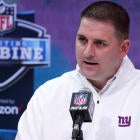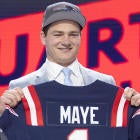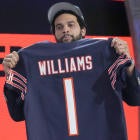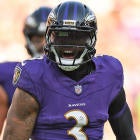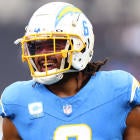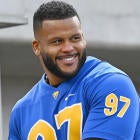Draft weekend provides an interesting window into how teams think. You learn a lot about not just what teams think they are, but also what they want to be, and how they plan on becoming the ideal version of the team they're trying to build. More than any others, this is true for the teams with new coaches and/or lead executives in place, because the draft is their first opportunity to add cost-controlled talent that will be with them for the long term.
This year, we had seven such teams: Washington (Ron Rivera), plus the Giants (Joe Judge), Panthers (Matt Rhule), Browns (Andrew Berry and Kevin Stefanski), Jets (Joe Douglas), Cowboys (Mike McCarthy), and Texans (the GM-version of Bill O'Brien). In the space below, we're going to detail each team's theory of the draft, and how they used it to build the kind of roster they want to have moving into the future.
Washington: Help for Haskins
- EDGE Chase Young (2)
- RB/WR Antonio Gibson (66)
- OT Saahdiq Charles (108)
- WR Antonio Gandy-Golden (142)
- TRADE: LT Trent Williams for No. 156, 2021 third
- OC Keith Ismael (156)
- LB Khaleke Hudson (162)
- S Kamren Curl (216)
- EDGE James Smith-Williams (229)
Dwayne Haskins had one of the worst supporting casts in the NFL last season, and his performance suffered greatly for it. While Ron Rivera and Washington had a chance to stack a whole bunch of draft capital by moving down from the No. 2 pick if they wanted to, they instead took a guy many considered the best prospect in the draft and then spent the rest of the weekend getting Haskins a whole bunch of help.
Gibson is a true running back/wide receiver hybrid, and he's equally explosive in both roles. He's essentially a touchdown waiting to happen, and offensive coordinator Scott Turner has already compared him to Christian McCaffrey, just so you have an idea of how they plan to use him. Giving Haskins another big target on the outside in Gandy-Golden was a good move, and he should make for a nice complement to Terry McLaurin.
Trent Williams was never going to play for this team anyway, and salvaging two draft picks out of him isn't such a bad result. They landed tackle Saahdiq Charles as well, and if he hadn't had so many off-the-field issues in college he might have been a much earlier pick. Adding Ismael with one of the picks from the Williams trade made sense as well, given the injury issues this team has had along the offensive front in recent seasons.
Giants: Business as usual
- OT Andrew Thomas (4)
- S Xavier McKinney (39)
- OT Matt Peart (99)
- CB Darnay Holmes (110)
- OG Shane Lemieux (150)
- LB Cam Brown (183)
- EDGE Carter Coughlin (218)
- LB T.J. Brunson (238)
- CB Chris Williamson (247)
- LB Tae Crowder (255)
Remember all those rumors about how the Giants couldn't wait to trade down from No. 4? How Dave Gettleman was going to trade down for the first time in his entire history as a general manager? Yeah, that didn't happen. Instead, even with a new head coach in Joe Judge, Gettleman did what Gettleman usually does: stuck at every spot and drafted a bunch of hog mollies and defenders.
The top four tackles were pretty close together on nearly everybody's board, so you can't necessarily fault Gettleman for taking Thomas over Jedrick Willis, Mekhi Becton, or Tristan Wirfs. If that's the tackle he felt best about protecting Daniel Jones' blind side, then that's the direction he should have gone. Adding a couple more offensive linemen later in the draft made sense as well, and Peart, in particular looks like he might be able to develop into a starter a year or two down the line.
The Giants also came into the draft with several needs on defense, and Gettleman did a decent job addressing them. New York's run defense was solid last year (seventh in Football Outsiders' DVOA) and should be again given the team's talent up the middle, but they needed to bring in a bunch of help against the pass. Signing James Bradberry was a good start, but they needed more. Adding Xavier McKinney at the top of Round 2 was terrific value, and Darnay Holmes was one of the better Day 3 corners available. The Giants still need a bunch of help in the pass rush department, but you can only address so many needs in one draft.
Panthers: Defensive makeover
- IDL Derrick Brown (7)
- EDGE Yetur Gross-Matos (39)
- TRADE: No. 69, 148 for No. 64
- S Jeremy Chinn (64)
- CB Troy Pride (113)
- S Kenny Robinson (152)
- IDL Bravvion Roy (184)
- CB Stantley Thomas-Oliver III (221)
In a completely unprecedented move, Matt Rhule and the Panthers used all seven of their draft picks on defensive players, something that no team had done in the modern history of the draft. (Which dates all the way back to 1967.) Carolina used some of its free-agent and trade capital to get some help on offense, bringing in Teddy Bridgewater to replace Cam Newton, swapping Trai Turner for Russell Okung, and then signing Robby Anderson away from the Jets.
The Panthers' defense was one of the worst in the NFL last season (25th in DVOA), so it was definitely in need of a dramatic facelift coming into the draft. After finishing 32nd against the run in 2019, the Panthers let Dontari Poe and Gerald McCoy each leave for the Cowboys, then used the No. 7 and 184 overall picks on interior defenders who could help shore things up inside. After allowing James Bradberry to leave for the Giants, they spent two Day 3 picks on corners. After cutting ties with Eric Reid, they used second and fourth-round selections on safeties. And after allowing Mario Addison to leave for Buffalo, they brought in a new edge rushing partner for Brian Burns at the top of the second round.
This is still going to be a long-term project for the Panthers and they may not have made the most optimal selection at each specific spot, but it's difficult to argue with their overall plan to go out and aggressively address their myriad needs on the defensive side of the ball.
Browns: Analytics and athletes
- OT Jedrick Wills (10)
- TRADE: No. 41 for No. 44, 160
- S Grant Delpit (44)
- TRADE: No. 74, 244 for No. 88, 2021 third
- IDL Jordan Elliott (88)
- LB Jacob Phillips (97)
- TE Harrison Bryant (115)
- C Nick Harris (160)
- WR Donovan Peoples-Jones (187)
The first draft for Andrew Berry and Kevin Stefanski was extremely analytics-heavy. Cleveland traded down twice, accumulating a bunch of extra capital this year and adding a free third-rounder in next year's draft as well.
They also landed several terrific athletes in Wills (72nd percentile for offensive linemen in SPARQ), Phillips (70th percentile for linebackers), and Peoples-Jones (99th percentile for wide receivers). They addressed major needs with their first two picks of Wills and Delpit, then stacked on top of a position of strength by taking Elliott after their third-round trade-down. Elliott ranked first among interior defenders in Adjusted Overall Win Rate, a good sign for his potential to contribute alongside Larry Ogunjobi and Sheldon Richardson on the inside. (Adjusted Overall Win Rate is a combination of Pro Football Focus' Pass Rush Win Rate and Run Stops, weighted so that pass rush is more important than run defense.)
Center Nick Harris didn't fill an immediate need and he's not a superior athlete, but he's a strong scheme fit in Stefanski's offense and has some time to develop behind incumbent center J.C. Tretter, whose contract becomes moveable at the end of the 2020 season.
Jets: Also analytics and athletes
- OT Mekhi Becton (11)
- TRADE: No. 48 for No. 59, 101
- WR Denzel Mims (59)
- S Ashtyn Davis (68)
- EDGE Jabari Zuniga (79)
- TRADE: No. 101 for No. 125, 129, 2021 sixth
- RB Lamical Perine (120)
- QB James Morgan (125)
- OT Cameron Clark (129)
- CB Bryce Hall (158)
- P Braden Mann (191)
- TRADE: No. 211 for Quincy Wilson
New York does not have a new coach, but general manager Joe Douglas was working his first draft with the team this weekend. Like Berry and the Browns, the Jets traded down twice in this draft, securing a bunch of extra capital and a future pick. The two deals turned pick No. 48 into Nos. 59, 125, and 129, plus a sixth-rounder in next year's draft. Picking up that additional sixth allowed them to send this year's sixth to the Colts in exchange for cornerback Quincy Wilson, who was a second-rounder in 2017 but has been beset by injuries so far in his career.
Even after moving down 11 spots in the second round, the Jets were able to land Sam Darnold a new top target in Baylor wideout Denzel Mims, who is a 95th percentile athlete and the fourth most athletic wideout in the class. Mims will be 23 soon so he's a bit on the older side, but he's got great size, speed, and body control. The Jets prioritized uber-athletes early on, with monster-sized Mekhi Becton in the first, and then lightning-fast track athlete Ashtyn Davis and twitchy edge rusher Jabari Zuniga in the third.
The Jets' Day 3 picks didn't necessarily fit the mold quite as much; but they did continue addressing their biggest need by adding a developmental tackle, and taking a quarterback on Day 3 is always an analytics-friendly move as well.
Cowboys: Best player available
- WR CeeDee Lamb (17)
- CB Trevon Diggs (51)
- IDL Neville Gallimore (82)
- CB Reggie Robinson (123)
- TRADE: No. 164, 2021 fifth for No. 146
- C Tyler Biadasz (146)
- EDGE Bradlee Anae (179)
- QB Ben DiNucci (231)
Nobody expected CeeDee Lamb to be on the board when the Cowboys came on the clock at No. 17 overall. That includes the Cowboys themselves, and probably Lamb as well. With needs all over on defense, they stuck to their board and took the player they said they had graded as the top receiver and No. 6 overall player in the class, trusting that they could fill their defensive needs later on.
In Round 2, they got similarly lucky. Stephen Jones said after Day 2 that in only 1 percent of their draft simulations did Trevon Diggs fall to them at No. 51. They considered taking him at No. 17, and might have done it had Lamb not been on the board. The same is true of Gallimore, who fell into their laps at No. 82 after having been under consideration for them in the previous round.
Dallas' move up the board for Wisconsin center Tyler Biadasz makes a good degree of sense, especially when you consider the cost to them was only a 2021 fifth-round pick, which they should get back thanks to the compensatory formula. He's unlikely to step in and replace Travis Frederick right away (Joe Looney and/or Connor McGovern should get first shot), but in a couple years, he might be able to take the job. Dallas didn't appear to consider edge quite as much of a need as it seemed from the outside, but still added Anae in the fifth round to address it anyway.
Texans: Throw stuff at the wall
- IDL Ross Blacklock (40)
- EDGE Jonathan Greenard (90)
- TRADE: No. 111 for No. 136, 141
- TRADE: No. 136, 248, 250 for No. 126
- OT Charlie Heck (126)
- CB John Reid (141)
- WR Isaiah Coulter (171)
I'm not entirely sure what Bill O'Brien is doing. After trading for and then lavishing Laremy Tunsil with a monster extension, sacrificing a third-rounder to get Duke Johnson, sending DeAndre Hopkins out of town for an overpaid running back (David Johnson) and a second-round pick, signing Randall Cobb, trading for Brandin Cooks, and whatever else he wanted this offseason, the Texans used their first two picks on front seven defenders despite having copious needs on the offensive line and in the secondary. They addressed those later, but actually traded up and sacrificed even more draft capital to do it. And then they drafted another receiver. If you know what this team's plan is, you know a lot more than I do.













